It may seem oxymoronic to associate the words Coventry and Heritage in the same headline, but behind the headlines of post-war concrete, there’s quite a lot of the old stuff left.
In any other city, in fact, the amount of heritage that’s visible would be a matter of pride, but Coventry was quite famously firebombed during WW2 and before that was one of the jewels in the crown of medieval cities to visit.
Lots of little roads and old houses to admire, and a mighty Cathedral in the centre.
When the war was over, it was frankly, never likely to be possible to save much of the burnt-out ruins, so they rebuilt, tearing down what remained to create the Coventry of today.
Now I am going to be contrary, but if you look around, what they built in the 1960s isn’t actually that bad. There’s some pretty decent stuff in the centre, and at the time, ideas such as pedestrianised shopping areas were genuinely radical.
If anything, what’s spoiling Coventry now is not the 1960s, but the 2000s. There’s a worrying amount of stuff going up that’s overlooking the city centre, and like many modern towers, they are bland to the point of being almost offensive. A new brick-clad row of shops fronting that famous pedestrian area is someone’s very poor idea of how to use modern materials to hint at a vague dose of history. It’s vulgar cheapness that sits ill at ease with the proudly defiant 1960s architecture around it.
However, if older is what you want, there are quite a few lumps lying around to find. There seems to be a trail to follow, but I was unable to find out details, so just wandered around stumbling upon delights.
Muchfriars Gatehouse
Grade II* listed building that formed part of the city wall. Whitefriars Gatehouse originally dates from 1352 and was extended during the 18th & 19th centuries.
It’s looking a bit shabby at the moment as it was damaged by arson in 2008 and has been empty since but was sold recently as it is still viable for use as a home.
Medieval Ruin
Possibly late 13th century, and was revealed during the post-war clearance. Thought to be a merchants house, associated with the nearby friary, but archaeologists are not sure, hence the very descriptive name of “medieval ruin”.
The site of the building was excavated in 1971, and archaeologists discovered pottery from the 13th and 14th centuries.
Bayley Lane
The remains of a medieval house that once stood on the site, now a rather curious bit of heritage standing alone in a park.
The road itself is thought to follow the line of the outer ditch or bailey of the former Coventry Castle, founded by the Earls of Chester between 1088 and 1147.
Lychgate Cottages
These charming 15th-century cottages were nearly torn down in the post-war period, following substantial damage, but have been restored, even if around the site, it’s mostly a branch of Wetherspoons occupying them.
Go around the other side though, and in a depression can be found the remains of the old church on the site, with a lovely pedestrian bridge right across the top.
NatWest Bank
(OK, it’s not medieval, but it’s worth noting)
Take a look at the stunning door made from stainless steel and decorated with motifs from British, Irish and ancient Greek coins. Also look at the top, where it has the crest of the City of London, for this was formerly a branch of the National Provincial Bank which adopted a design based on its headquarters in London.
While not obvious unless told, this building also marked a radical change in bank design, which were usually nothing more than a grand doorway leading to the bank hidden behind a row of shops.
To have an entire frontage dedicated to the bank, which is today commonplace was when this was built, quite radical.
22 & 23 Bayley Lane
Next to the old Cathedral, this cottage built around 1500 is the only surviving example of its type in an area that until WW2 was full of them.
The decorative woodwork is probably 17th century and the windows date from the 19th century.
Swanswell Gate
Completed around 1440 as part of the fortified town wall, it gave access to the Prior’s lands outside the city, including the Swanswell fishpool.
It was converted into a house in 1932, with the arch being blocked and the roof raised. Look for the carving above the door which shows its heritage.
Old Grammar School
A recently refurbished 12th-century building which was the former Hospital of St John.
Not open when I was there, it does open for special events.
Spon Street
This is about as close Coventry seems to get to promoting its heritage, with plenty of signs to the “Medieval Spon Street”, and while undeniably it’s a street lined with medieval buildings, it’s actually a bit of a letdown.
It needs the cars to be removed, and had this been any other city, you’d have cobbled pedestrian street and it’d be filled with craft shops and cafes.
Here it looks a bit forlorn. Sadly.
Ford’s Hospital
OH MY GOSH!
This is a row of almshouses endowed in 1509 by William Ford and built around this astonishing courtyard. You cant go into the courtyard, but the gate lets you peer through into it.
It’s said to be one of the best examples of timber-framed architecture in the entire UK. Damaged by the blitz, it was fortunately rebuilt with the original timbers in the 1950s.
If it looks familiar to some, it was used for a filming location in the Doctor Who story, The Shakespeare Code.
Manor Yard
The former gatehouse to Cheylesmore Manor, which was the former 14th-century royal palace owned by the Black Prince. The gatehouse was restored in 1968.
The building used to be the only unfortified royal palace outside London and is now better known as the Register Office, being the oldest building in the country to hold that function.
Coventry Cathedral
OK, yes, of course, there’s the famous ruins of Coventry Cathedral, with its huge open courtyard space to sit and relax in. Dotted around are some monuments to the former occupants, and still dominating the skyline the old tower.
I rather foolishly glanced at the opening hours without my glasses and thought the tower closed at 5pm. It closes at 3pm, so I missed out on a chance to climb up to see the city from above.
I also, therefore, missed out on going into the modern cathedral proper but was allowed to stand at the back quietly and admire the view while a service was taking place.
I also missed…
A large medieval era hall with stained glass windows and collections of armour and furniture.



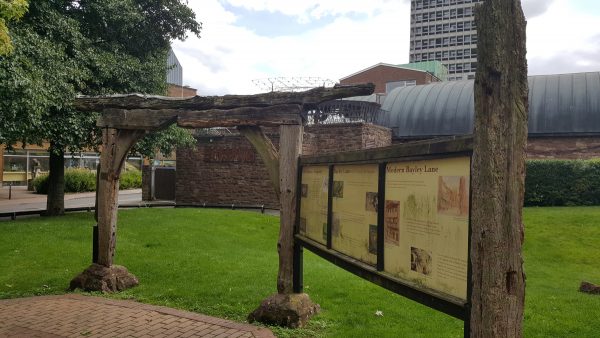
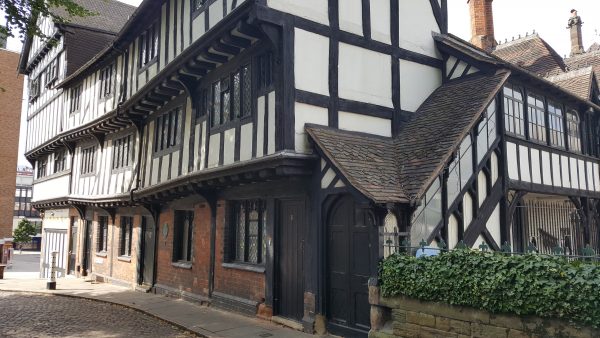

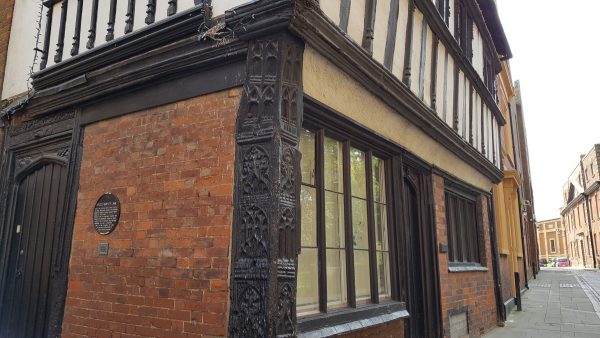
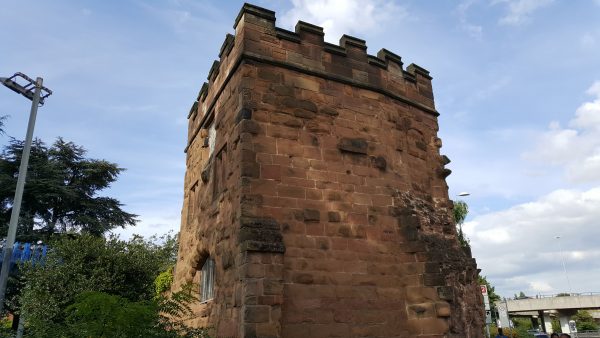

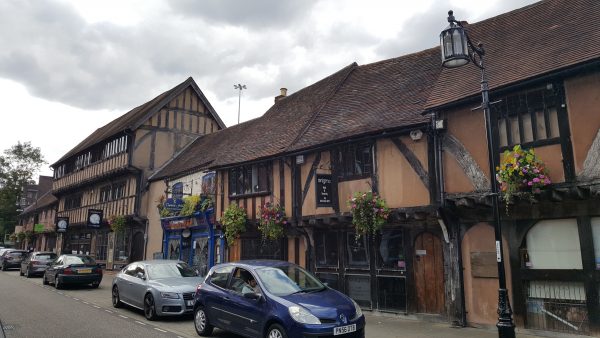

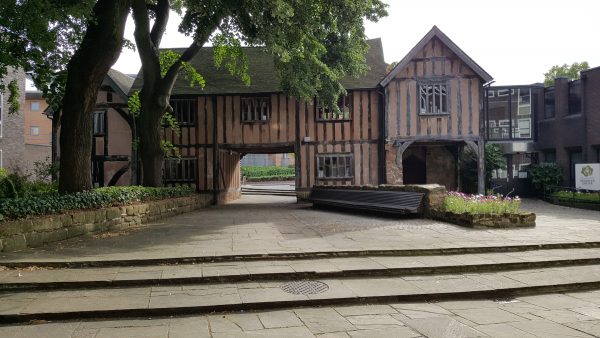
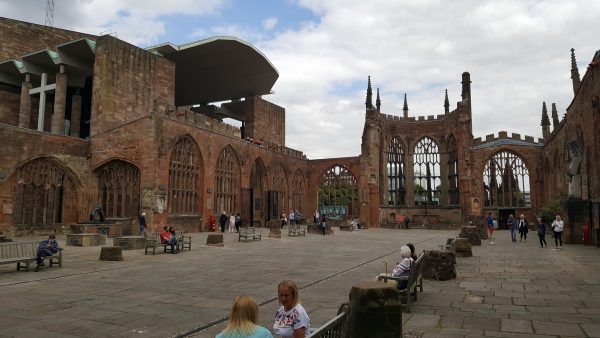
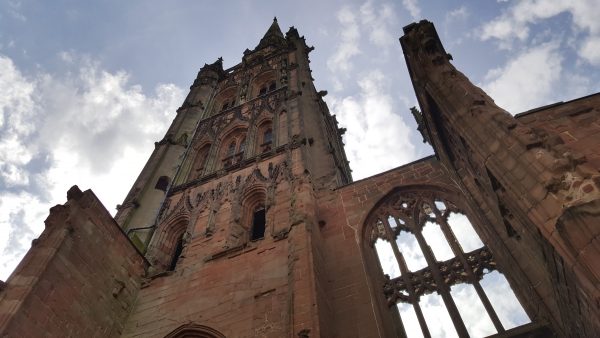






In the early 1970s I was a student at the Lanchester Poly’ (which became Coventry Poly’ en-route to becoming Coventry University) which is just over the road from the Cathedral.
What you didn’t mention is that Spon Street is mostly a collection of buildings rescued from elsewhere in the city as redevelopment took place.
Also, if I remember correctly, the Muchfriars Gatehouse was once a toy museum.
My wife’s nephew got married in St. Mary’s Guildhall!